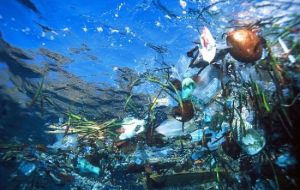MercoPress. South Atlantic News Agency
Researchers discover a huge North Atlantic Garbage Patch
 Thousands of square kilometres of plastic garbage adrift
Thousands of square kilometres of plastic garbage adrift A vast patch of floating plastics garbage extending for thousands of square kilometres in a remote area of the North Atlantic has been documented by two different groups of scientists sailing from Bermuda to the Azores islands.
One of the studies describes an accumulation of micro-particles similar to the so called Pacific Garbage Patch, which was discovered a decade ago somewhere between Hawaii and California and which according to scientists could be repeated in other oceans.
“We have found the great Atlantic garbage patch” said Anna Cummins who collected samples of floating plastic during the trip last February.
The floating residue are harmful for fisheries, for marine mammals and potentially humans who are at the cusp of the food chain, even when the plastic particles have pulverized to such an extent that they are hard to see.
How there’s no real method to clean oceans scientists argue it is vital to eliminate plastic garbage creating awareness of the risks and dangers, basically by changing the culture of using resistant materials.
“Our task is to make people understand that contamination with plastics in the oceans is a global problem, which unfortunately is not confined to an only area”, said Cummins.
Research groups made a presentation of their conclusions last February in the Ocean Sciences meeting in Portland, Oregon although scientists have been reporting plastic garbage in the Atlantic since the seventies.
Cumminis and her husband Marcus Eriksen from California sailed across the Atlantic for their research project and are planning similar cruises in the South Atlantic next November and in the South Pacific in the coming weeks.
In the leg from Bermuda to the Azores they crossed the Sargasso Sea, an area bounded by ocean currents including the Gulf Stream. They took samples every 160 kilometres with one interruption caused by a major storm. Each time they pulled up the trawl, it was full of plastic.
A separate study by undergraduates with the Woods Hole, Massachusetts-based Sea Education Association collected more than 6,000 samples on trips between Canada and the Caribbean over two decades. The lead investigator, Kara Lavendar Law, said they found the highest concentrations of plastics between 22 and 38 degrees north latitude, an offshore patch equivalent to the area between roughly Cuba and Washington, D.C.
Long trails of seaweed, mixed with bottles, crates and other flotsam, drift in the still waters of the area, known as the North Atlantic Subtropical Convergence Zone. But the most nettlesome trash is nearly invisible: countless specks of plastic, often smaller than pencil erasers, suspended near the surface of the deep blue Atlantic.
Charles Moore, an ocean researcher credited with discovering the Pacific garbage patch in 1997, said the Atlantic undoubtedly has comparable amounts of plastic. The east coast of the United States has more people and more rivers to funnel garbage into the sea. But since the Atlantic is stormier, debris there likely is more diffuse, he said.
Whatever the difference between the two regions, plastics are devastating the environment across the world, said Moore, whose Algalita Marine Research Foundation based in Long Beach, California, was among the sponsors for Cummins and Eriksen.
“Humanity's plastic footprint is probably more dangerous than its carbon footprint,” he said.




Top Comments
Disclaimer & comment rulesCommenting for this story is now closed.
If you have a Facebook account, become a fan and comment on our Facebook Page!